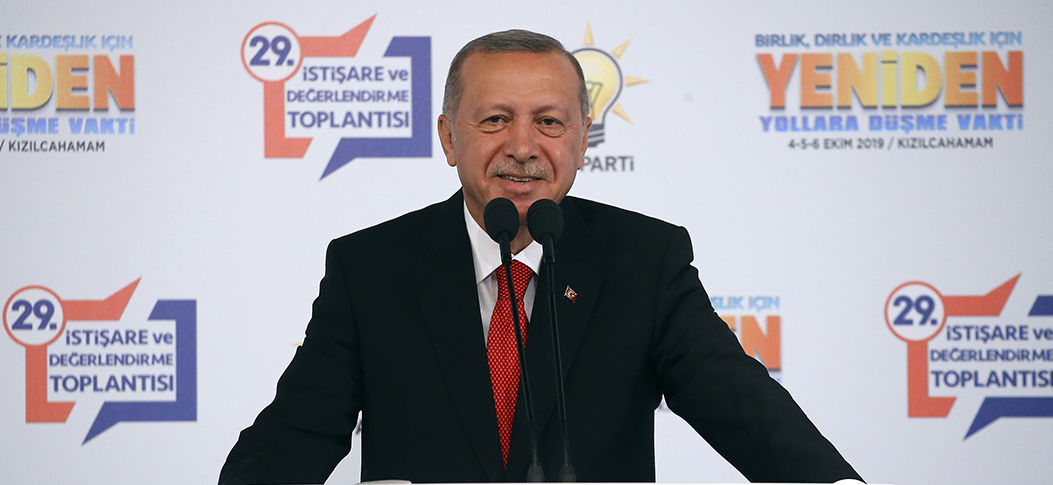President Erdoğan: We now have two seismic research ships and two drilling vessels

President Recep Tayyip Erdoğan spoke at the ruling Justice and Development (AK) Party’s 29th Consultation and Assessment meeting in Kizilcahamam.
"Turkish Petroleum has surpassed 50,000 barrels (per day) of domestic oil production, breaking the record for the last 20 years," the president said.
"We want to extend this [fracking] method even more, and we will continue to open new wells," he added.
The hydraulic fracturing method, which uses pressurized water and chemicals, is a widespread technique used in the U.S.’ oil and natural gas industry.
With the method, the U.S., now the world’s biggest oil and gas producer, enabled to increase its crude oil production from 5 million barrels per day (bpd) in 2008 to 10.99 million bpd in 2018, according to the Energy Information Administration data.
Hydraulic fracturing could also be used for natural gas, as Erdoğan said Turkey has made new discoveries in the country’s northwestern region.
"At he beginning of this year, we have discovered new fields in [northwestern] Thrace that doubled our total natural gas reserves. Those fields hold around 3 billion cubic meters of gas, which will meet the gas demand of 300,000 households for 10 years," he said.
OPERATIONS IN MEDITERRANEAN
Turkey is also exploring oil and gas resources in the eastern Mediterranean Sea, as its Yavuz drilling vessel has reached Guzelyurt-1 well in the region earlier Saturday for its second expedition.
While a second drilling vessel, Fatih, continues its operations in the region, MTA Oruc Reis and Barbaros Hayreddin Pasa seismic research ships conducted seismic surveys in the Black Sea and Marmara Sea in the past.
"We now have two seismic research ships and two drilling vessels. There could be a third drilling ship that we can add to that, so we won’t have any trouble to rent it from elsewhere," Erdoğan said.
The president noted that Fatih vessel has drilled below 4,000 meters, while MTA Oruc Reis has completed 30% of its seismic survey off the coast of Antalya in southern Turkey.
Turkey consumed 47.3 billion cubic meters of natural gas last year, according to BP Statistical Review of World Energy 2019 report, but it is still highly dependent on importing natural gas from other countries.
To lower its energy bill, the country tries to diversify its energy portfolio by focusing on renewables.
"We have delivered natural gas to all of our 81 cities by the end of 2018 as we promised," Erdoğan said. "We have increased electricity production from domestic resources to 65%. That way we don’t pay $1.5 billion abroad."
"Renewables’ share in electricity production has increased to 48.5%," he stated, adding that Turkey will hold a tender this year to offer 1,000 megawatts of capacity in four regions.
The president said that a number of domestic and foreign energy companies have already applied for the bidding.
PIPELINE PROJECTS
Two key pipeline projects will also provide Turkey with plenty of gas in near future when they are completed.
This year, first gas flow via TurkStream will begin from Russia to Turkey, Erdoğan said.
Trans-Anatolian Natural Gas Pipeline (TANAP), which will carry gas from Azerbaijan to Europe, also saw its second phase between Turkish cities Eskisehir in central Anatolia and Edirne in northwestern region.
GAS STORAGE
Turkey also has projects for gas storage in order to preserve its natural gas need during winter season and protect itself from price fluctuations in the market.
Erdoğan said the last phase of Salt Lake natural gas storage facility is underway, which will increase its capacity to 5.4 billion cubic meters by 2023.
The facility currently has a gas capacity of 600 million cubic meters, and it is 100% full, he said, adding that this capacity will double by 2021.
While Turkey has rich boron resources, Erdoğan said there will be a new project using advanced technology to use the boron mineral.
"With a factory that we will build in Balikesir, we will use boron carbide to produce tactical vehicles, helicopters, airplanes, armored vehicles and protective vests," he added.

